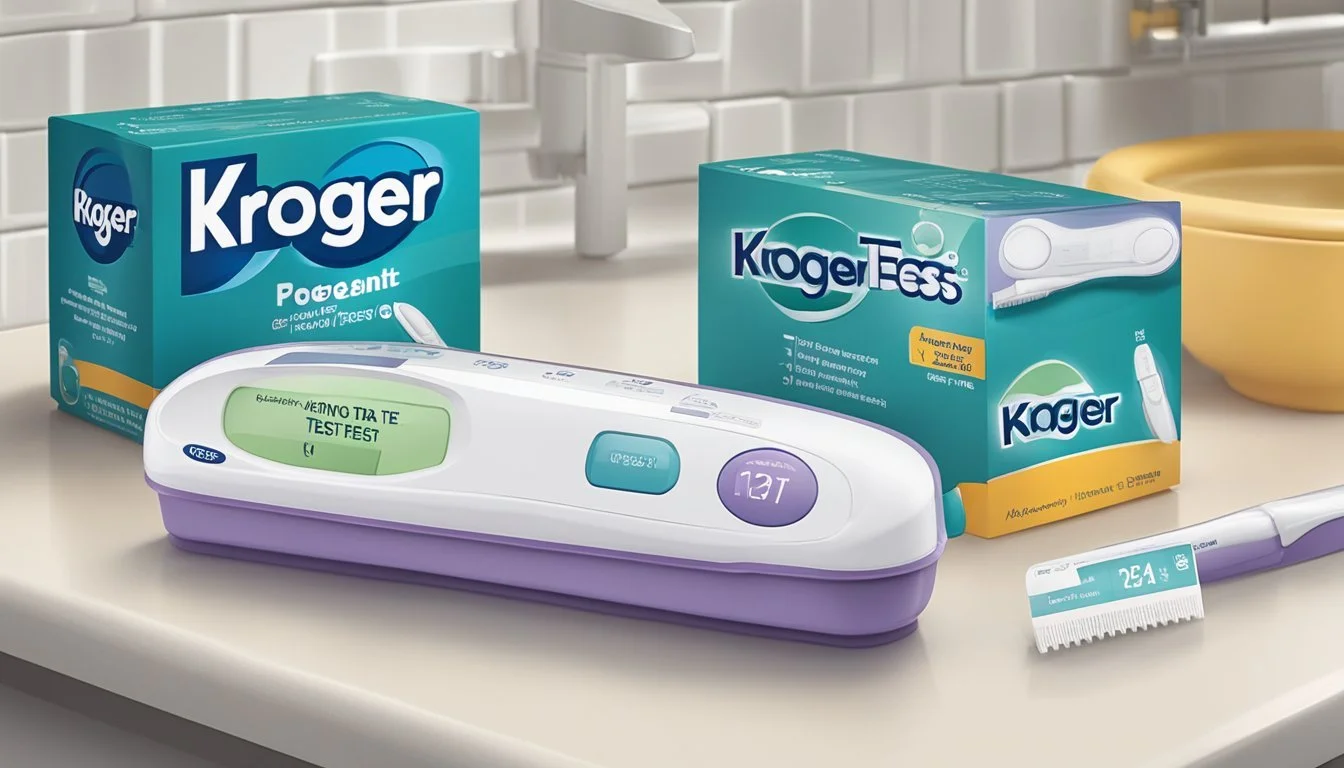Kroger Pregnancy Test
Accuracy and Reliability Explained
Kroger pregnancy tests offer a reliable and affordable option for women seeking to confirm a potential pregnancy. These tests detect human chorionic gonadotropin (hCG), a hormone produced during pregnancy, in urine. Kroger's pregnancy tests are over 99% accurate when used correctly, providing results comparable to more expensive brands.
Kroger offers several types of pregnancy tests, including digital and traditional line tests. The digital tests feature an easy-to-read display, while the line tests use the familiar two-line system to indicate results. Both options can detect pregnancy as early as the first day of a missed period, giving women quick answers to their questions.
Home pregnancy tests like those offered by Kroger have revolutionized family planning, allowing women to check for pregnancy in the privacy of their own homes. These tests are designed to be user-friendly, with clear instructions and rapid results. Kroger's pregnancy tests typically provide results within 2-3 minutes, making them a convenient choice for women eager to know their status.
Understanding Pregnancy Tests
Pregnancy tests are essential tools for detecting early pregnancy. They rely on identifying specific hormones in urine to provide accurate results. The science behind these tests, their timing, and the role of human chorionic gonadotropin (HCG) are crucial factors in their effectiveness.
Role of HCG in Pregnancy Detection
Human chorionic gonadotropin (HCG) is a hormone produced by the placenta shortly after conception. It plays a vital role in pregnancy detection. HCG levels rise rapidly in early pregnancy, doubling approximately every 48-72 hours.
Home pregnancy tests are designed to detect HCG in urine. The presence of this hormone indicates pregnancy. Most tests can detect HCG as early as 10-14 days after conception, though sensitivity varies between brands.
HCG levels continue to increase throughout the first trimester, peaking around weeks 8-11. After this period, levels gradually decline and stabilize for the remainder of the pregnancy.
The Science Behind Home Pregnancy Tests
Home pregnancy tests use antibodies to detect HCG in urine. These antibodies are specifically designed to bind to HCG molecules. When urine containing HCG comes into contact with the test strip, it triggers a chemical reaction.
This reaction produces a visible result, typically in the form of lines, colors, or digital displays. Most tests use a two-line system:
Control line: Confirms the test is working correctly
Test line: Indicates the presence of HCG
The intensity of the test line can vary depending on HCG concentration. However, any visible line, no matter how faint, generally indicates a positive result.
The Importance of Timing in Pregnancy Testing
Timing is crucial for accurate pregnancy test results. Testing too early can lead to false negatives, as HCG levels may not be high enough for detection. Most tests are most accurate when taken after a missed period.
For highest accuracy, it's recommended to:
Wait until at least one day after a missed period
Use first-morning urine, which has the highest HCG concentration
Avoid excessive fluid intake before testing, as it can dilute urine
Some tests claim to detect pregnancy earlier, up to 6 days before a missed period. However, these results may be less reliable. If a test is negative but pregnancy is still suspected, it's advisable to retest in a few days.
Types of Kroger Pregnancy Tests
Kroger offers two main types of pregnancy tests designed for easy use and accurate results. These tests provide women with reliable options for early pregnancy detection at home.
Kroger One Step Pregnancy Test
The Kroger One Step Pregnancy Test is a straightforward and user-friendly option. It features a simple stick format with an absorbent tip. Users hold the tip in their urine stream for 5 seconds to collect a sample. Results appear within 2 minutes, indicated by lines on the test window.
This test can detect pregnancy as early as the first day of a missed period. It boasts over 99% accuracy when used correctly. The One Step test is affordable and often comes in multi-packs for repeated testing.
Kroger Digital Pregnancy Test
Kroger's Digital Pregnancy Test offers a modern approach with clear, unambiguous results. It features an easy-to-read digital display that shows either "Pregnant" or "Not Pregnant" after 3 minutes.
This test can detect pregnancy from the day of the expected period. It eliminates the need to interpret lines, reducing user error. The digital format is particularly helpful for those who find traditional line tests confusing.
Like its analog counterpart, the Digital Pregnancy Test is over 99% accurate. It provides early detection of the pregnancy hormone hCG in urine samples.
How to Use Kroger Pregnancy Tests
Kroger pregnancy tests are designed for easy and accurate at-home use. These tests detect the presence of hCG hormone in urine to indicate pregnancy. Proper usage ensures reliable results.
Preparing for the Test
Check the expiration date on the test package before use. Store tests at room temperature away from direct sunlight. For best results, use first morning urine when hCG levels are most concentrated. Collect urine in a clean, dry container if not testing directly in the urine stream. Wash hands thoroughly before handling the test.
Read all instructions carefully before starting. Gather necessary supplies:
Kroger pregnancy test
Timer or clock
Clean cup (if not testing in urine stream)
Open the foil pouch just before use to prevent contamination. Familiarize yourself with the test stick and result window.
Steps for Taking the Test
Remove the cap from the test stick.
Hold the absorbent tip in your urine stream for 5 seconds. Alternatively, dip the tip into collected urine for 5-10 seconds.
Replace the cap and lay the test flat on a level surface.
Start a timer for 2-3 minutes.
Do not disturb the test while waiting for results.
Read results within 10 minutes. Disregard any changes after this time.
Interpreting Test Results
Positive Result: Two distinct lines appear in the result window. Even a faint second line indicates pregnancy.
Negative Result: Only one line appears in the control area.
Invalid Result: No lines appear, or only a test line is visible without a control line.
If results are negative but you still suspect pregnancy, wait 48 hours and test again. hCG levels double every 2-3 days in early pregnancy.
For unclear results, repeat the test or consult a healthcare provider. False negatives can occur if testing too early before a missed period.
Accuracy and Sensitivity
Kroger pregnancy tests offer high accuracy and sensitivity for detecting pregnancy hormones. These key factors impact test reliability and early detection capabilities.
Factors Affecting Accuracy
Kroger pregnancy tests are over 99% accurate when used correctly. Proper timing is crucial - testing too early can lead to false negatives. Following instructions carefully improves accuracy. Using first morning urine provides the most concentrated hormone levels.
Test expiration dates matter. Expired tests may give inaccurate results. Proper storage in a cool, dry place maintains test quality. Certain medications or medical conditions can potentially interfere with results.
User error can impact accuracy. Misreading results or not waiting long enough for lines to appear may lead to incorrect interpretations. Consulting the instructions and waiting the full recommended time is important.
Understanding Test Sensitivity
Kroger pregnancy tests have a sensitivity of 25 mIU/mL of hCG. This allows detection as early as 4 days before an expected period for some women. Higher sensitivity means earlier detection potential.
Test sensitivity impacts how soon pregnancy can be confirmed after conception. Lower hCG thresholds enable earlier positive results. However, hormone levels vary between women and pregnancies.
False negatives are possible if testing occurs too early. Retesting a few days later is recommended if the first result is negative but pregnancy is still suspected. False positives are rare but can occur due to certain medications or medical conditions.
Troubleshooting Common Issues
Pregnancy tests can sometimes produce confusing or unexpected results. Understanding how to interpret unclear outcomes and when to retest can help ensure accurate results.
Dealing With Unclear Results
Faint lines on a Kroger pregnancy test can be perplexing. A very light second line may indicate a positive result, but it's not always definitive. Check the test within the recommended timeframe, usually 3-5 minutes. Reading too early or too late can lead to misinterpretation.
Evaporation lines can also cause confusion. These appear as the urine dries and are typically colorless or gray. True positive lines are usually pink or blue. If unsure, take another test in 24-48 hours.
Digital tests eliminate line interpretation issues but can malfunction. If the display shows an error message or remains blank, the test may be faulty. Use a new test and follow instructions carefully.
When to Retake the Test
Retesting is often necessary for conclusive results. Wait at least one day before taking another test if the first result was unclear. This allows hCG levels to increase if pregnancy has occurred.
For more reliable results, test again after a missed period. Early testing can lead to false negatives. Kroger Advanced Early Result tests can detect pregnancy up to 5 days before a missed period, but accuracy improves closer to the expected period date.
Consider retesting if:
The first result was negative but symptoms persist
The test line was very faint
You tested too early in your cycle
You drank excessive fluids before testing, potentially diluting urine
Use first-morning urine for retesting, as it contains the highest concentration of hCG.
Next Steps After Testing
After using a Kroger pregnancy test, there are important steps to take regardless of the result. A positive test requires medical follow-up, while a negative result may warrant retesting or consultation.
Confirming Pregnancy With a Healthcare Provider
Schedule an appointment with a healthcare provider promptly after a positive pregnancy test. They will conduct a blood test to confirm the pregnancy and check hormone levels. This visit allows for early prenatal care and screening for potential health issues.
The provider will estimate the due date and discuss prenatal vitamins. They may perform an ultrasound to verify the pregnancy's location and check for a heartbeat. This appointment is also an opportunity to address any concerns or questions about the pregnancy.
Planning for Pregnancy
Begin taking prenatal vitamins with folic acid to support fetal development. Review current medications with a doctor to ensure they are safe during pregnancy. Make healthy lifestyle changes, including quitting smoking and avoiding alcohol.
Start a gentle exercise routine and focus on a balanced diet rich in fruits, vegetables, and lean proteins. Stay hydrated by drinking plenty of water throughout the day. Consider joining prenatal classes or support groups to connect with other expectant parents.
Begin researching childbirth options and creating a birth plan. Look into health insurance coverage for prenatal care and delivery. Start planning for any necessary work accommodations or maternity leave.






